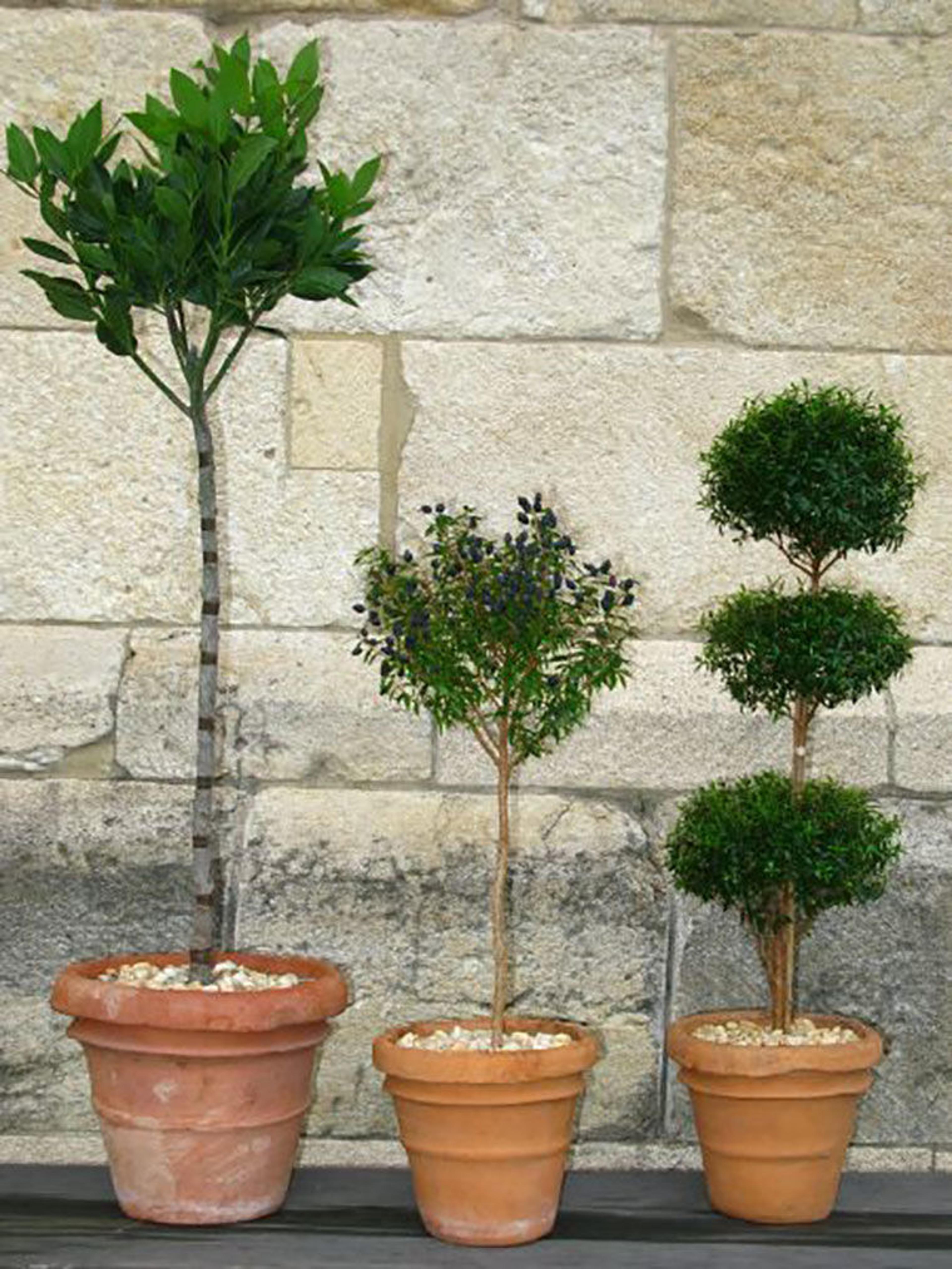The Medieval Garden Enclosed—The Art of Topiary
Medieval topiary was relatively simple and non-representational. Woody plants were trained to standards topped by balls, or to a characteristically medieval form known as an estrade, in which the plant was grown in tiers. Although these are rarely represented before 1400, many fifteenth-century artworks show estrades and other simple, geometric forms growing both in pots and in garden beds.The more ornate representational topiary known to the Romans was revived in Renaissance Italy; the Rucellai garden in Florence, created in the second half of the fifteenth century, included animals and human figures, as well as topiary temples and urns.
The practice of artfully clipping and training woody plants into formal or fanciful shapes can be traced back to imperial Rome and the Natural History of Pliny the Elder, who attributes the relatively recent invention of nemora tonsilia or "barbered groves" to one Gaius Matius, a Roman knight and a friend of the Emperor Augustus (John Boardman, The Oxford History of the Roman World, 2001).

Pictured, from left to right: bay laurel (Laurus nobilis) trained as a standard; myrtle (Myrtis communis) standard in fruit; myrtle trained as an estrade, a popular late-medieval form. The Romans, ever practical, especially valued bay laurel and myrtle as topiary subjects because the fragrant clippings could be used for chaplets (Linda Farrar, Ancient Roman Gardens, 1998.) In addition to bay laurel and myrtle, rosemary, santolina, germander, and other woody herbs continue to be popular subjects for topiary work.
To create a standard, a single strong stem is encouraged, and any side shoots are removed. The foliage that crowns the stem is pinched out to create the head, and the new growth is trimmed to the desired shape. It does take time and attention to create a display-worthy specimen, but it is not all that difficult (Barbara Gallup and Deborah Reich, The Complete Book of Topiary, 1987).
As well as a refreshing fragrance, the pretty gray foliage of cotton lavender (Santolina chamaecyparissus) provides a pleasing contrast to the leaves of other evergreen herbs used as topiary subjects, such as bay laurel and myrtle. Note: Potted herbs and bulbs are currently on display in Cuxa Cloister, which is glassed-in from mid-October through mid-April.

Our word topiary derives from another term, ars topiarium, used by Pliny in the much broader sense of ornamental gardening, although he does makes specific reference to tableaux rendered in clipped cypress as examples of opus topiarium. The Latin term topia, meaning "landscapes," is of Greek origin. A topiarius was a landscape or ornamental gardener. Many topiarii in the service of the imperial family and other wealthy Romans were slaves of Greek extraction (The Oxford Companion to Gardens, 1986). The popularity of topiary work is also attested in a letter of Pliny the Younger, in which he describes the ornament of his villa garden in Tuscany, with its topiary obelisks, figures, and letters of clipped box.

Detail from The Annunciation, 1465-75. Workshop of Rogier van der Weyden (possibly Hans Memling, active by 1465, died 1494) (Netherlandish, 1399/1400-1464). Oil on wood; 73 1/4 x 45 1/4 in. (186.1 x 114.9 cm). The Metropolitan Museum of Art, New York, Gift of J. Pierpont Morgan, 1917 (17.190.7)
From the window of the Virgin's house, we look out at a delightful vignette of a Netherlandish garden of the fifteenth century; at the back wall of the enclosed garden, a woman tends two potted shrubs trained to a tiered form, or estrade. Although the metal hoops which were often used to confine the foliage to the desired form are not visible here, they can be seen in other contemporary representations.
These shrubs may well be rosemary (Rosmarinus officinalis), which would necessarily have been brought indoors in northern winters, and would thus have been grown in containers.
Still strongly associated with formal gardens in both the French and Italian styles, topiary was cultivated in the gardens at Hampton Court Palace by the end of the sixteenth century, and enjoyed a long vogue in England, although it was not universally admired. In the seventeenth century, Sir Francis Bacon disparaged fancy forms as a childish taste, although he admired pyramids or columns. In the eighteenth century, the style was famously ridiculed by Alexander Pope in his Catalogue of Greens.
A number of famous topiary gardens in Europe, the U.K., and the U.S. are open to the public, and many handbooks, such as The Complete Book of Topiary by Barbara Gallup and Deborah Reich, and articles on the subject are widely available.
Deirdre Larkin
Deirdre Larkin is the managing horticulturist at The Met Cloisters museum and gardens.